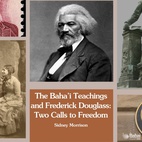The views expressed in our content reflect individual perspectives and do not represent the authoritative views of the Baha'i Faith.
As a physicist, I know the world as more than its visible surface might suggest — so I engaged early on with the ideas of scientists who consciously look beyond the boundaries of their respective disciplines.
This includes the German physicist and Nobel Prize winner Max Planck. As one of the fathers of quantum physics, which made modern life possible, he once said:
No matter where and how far we look, nowhere do we find a contradiction between religion and natural science … Religion and natural science do not exclude each other, as many contemporaries of ours would believe or fear; they mutually supplement and condition each other.
Planck addressed here an important principle known in the Baha’i Faith as the “unity of science and religion.” Baha’is believe that a mature and realistic worldview can only emerge when we equally consider essential insights from both science and religion. In a speech he gave in New York in 1912, Abdu’l-Baha said that:
… religion is in harmony with science. The fundamental principles of the Prophets are scientific, but the forms and imitations which have appeared are opposed to science. If religion does not agree with science, it is superstition and ignorance; for God has endowed man with reason in order that he may perceive reality. The foundations of religion are reasonable. God has created us with intelligence to perceive them.
RELATED: Answering Two Major Scientific Challenges to Religion
As the English biologist John B. S. Haldane expressed it: “The wise man regulates his conduct by the theories both of religion and science.” But how can we recognize that what is offered to us as knowledge actually corresponds to reality? Or to put it another way: How do we access reliable knowledge in both science and faith?
The Core of Scientific Methodology
In science, there is no such thing as THE scientific method, in the sense of a concrete recipe-like research protocol. However, there are fundamental methodological elements whose application made the success of science possible. This includes, in particular, the “scientific three-step,” in which the research of a phenomenon takes place in three repeating steps:
- Constructing an explanation for the given problem (model)
- Deriving logical consequences from the model (predictions)
- Critical testing of the theoretical predictions (experiment)
As long as the logical consequences (step 2) of the scientific model (step 1) can be observed in reality (step 3), the model is accepted and retained until further notice. If contradictions arise during the theory test, however, a new and better explanation must be found.
So, the core of scientific research, in this sense, involves a systematic process of trial and error that leads to increasingly better models of reality over time. As you can see, it doesn’t matter how a good theory came about — what matters is solely that the model can be tested, based on the resulting logical consequences, and consistently prove itself.
The Faith of Science
Of course, science is not as simple as this brief description makes it sound. Especially with complex phenomena, it is not always clear whether contradictions found in experiments are due to the flaws in the model, or if the theory’s demanded conditions are not being met. Therefore, it is not reasonable to immediately discard a well-proven theory if a supposed contradiction or anomaly occurs.
This is evident in the historical review of research practices: Scientific theories are always embedded in a framework beyond science itself. This framework — commonly referred to in the philosophy of science as a paradigm but also known as research tradition — constitutes the “traditional” background knowledge of scientists and significantly guides research. Besides confirmed fundamental models, a paradigm always includes “extra-scientific” assumptions — not only methodological principles (e.g., Occam’s razor) but also worldview theses (e.g., the assumption that nature adheres to a set of logical laws).
As sensible as such basic assumptions may be, they are not provable by science itself — they essentially represent the “faith of science.” Thus, neither absolute knowledge nor presupposition-free science exists, although some might wish to believe so.
Two Levels of Scientific Progress
Most scientific progress occurs slowly and steadily by elaborating the knowledge hidden in the research tradition, the scientific three-step. For centuries, for example, the paradigm of classical physics has served well, explaining various phenomena from falling objects to planetary movements.
However, scientific progress can also occur abruptly and revolutionarily. This happens when not only individual theories are improved but when, due to a “paradigm shift,” the entire scientific background knowledge changes. This usually comes with a completely renewed perspective on reality.
Rise and Fall of Scientific Paradigms
A paradigm shift is heralded by a scientific “crisis” when the explanatory deficiencies and anomalies of the established research tradition accumulate. More and more scientists then break out of the familiar and proven framework, seeking entirely different explanatory models. The crisis is resolved when a new paradigm becomes available, reproducing the explanatory power of its predecessor and simultaneously explaining new phenomena.
For instance, at the beginning of the 20th century, the failure of classical physics to describe atomic phenomena or high-speed particles led to the development of quantum physics and the theory of relativity. Both theories marked the end of classical physics and are essential components of the paradigm of modern physics today, suggesting a completely new, non-materialistic understanding of the nature of reality. Even today, scientists are busy elaborating on the treasures contained in this paradigm. Yet the day will certainly come when this powerful paradigm will reach its limits and be replaced by an even more comprehensive view of reality.
The Science of Religion
A study of the Baha’i writings reveals astonishing parallels to the insights of modern philosophy of science. They confirm that human knowledge, with its model-like and relative character, continually evolves — which explains why everything we know must ultimately remain incomplete and provisional.
It also shows that the approach to scientific research is based on general principles. According to the Baha’i writings, there are only four ways to acquire knowledge, namely through:
- Senses
- Reason
- Intuition
- Tradition
Anyone who has experienced an optical illusion knows that we cannot always trust our senses. The same applies to our reason, intuition, and what various traditions dictate to us. Because all four channels of knowledge are prone to error when utilized alone, their suitable combination, according to the Baha’i writings, becomes a methodological necessity:
A statement presented to the mind accompanied by proofs which the senses can perceive to be correct, which the faculty of reason can accept, which is in accord with traditional authority and sanctioned by the promptings of the heart, can be adjudged and relied upon as perfectly correct, for it has been proved and tested by all the standards of judgment and found to be complete.
Revelation and Paradigms
With regard to religious knowledge, the teachings of their own religion constitute the accepted background knowledge for most believers. Those beliefs, ideally after thorough examination, then become unquestioned traditions. The revelations of the great religious founders can thus be understood as paradigms that significantly guide the religious worldview and the lifestyles of believers. To correctly interpret and increasingly apply individual teachings for the benefit of all, believers now need the other three channels of knowledge — senses, reason, and intuition.
RELATED: The Harmony of Religion and Science: Both Principle and Prophecy
Consequently, nothing should be considered true that has been shown by science and reason to be impossible.
Over time, more and more facets of the principles contained in the teachings of a religion are understood and applied, creating new levels of human culture. However, these achievements should not obscure the fact that not only does people’s capacity increase over time, but external circumstances also change. Consequently, every religion, at some point, naturally loses its invigorating power. The Baha’i writings address this natural phenomenon by saying: “The religion of God is one religion, but it must ever be renewed.”
That important principle of renewal is called “progressive revelation” in the Baha’i writings. This completes the circle: just as there is only one science that continually evolves, ultimately, there is also only one religion, which progressively manifests itself in various and ever more comprehensive revelations.
Remarkably, then, both scientific and religious knowledge develop according to similar methodological principles. Surprisingly, for some, serious science involves a healthy amount of “faith,” while conversely, modern faith is scientific in its method.
In both cases, an overall paradigm or tradition forms the decisive perspective that allows us to look at the world knowledgeably. Once such a paradigm is established, it is not questioned for the time being and significantly guides the thinking and actions of researchers and believers alike. In religion, the paradigm corresponds to the respective revelation. Based on this, concrete knowledge is created through the combined application of the three other human channels of knowledge — senses, reason, and intuition. In science, these are systematized in the three-step form of modeling (intuition), predictions (reason), and experiments (senses). Just as every scientific paradigm must one day be replaced by a more powerful one, every religious revelation loses its vitality over the centuries and must be renewed.
An earlier version of this article first appeared on Perspektivenwechsel-Blog:
Die Wissenschaft der Religion — die Sicht eines Bahai und Physikers (perspektivenwechsel-blog.de)

















Comments
Sign in or create an account
Continue with Facebookor